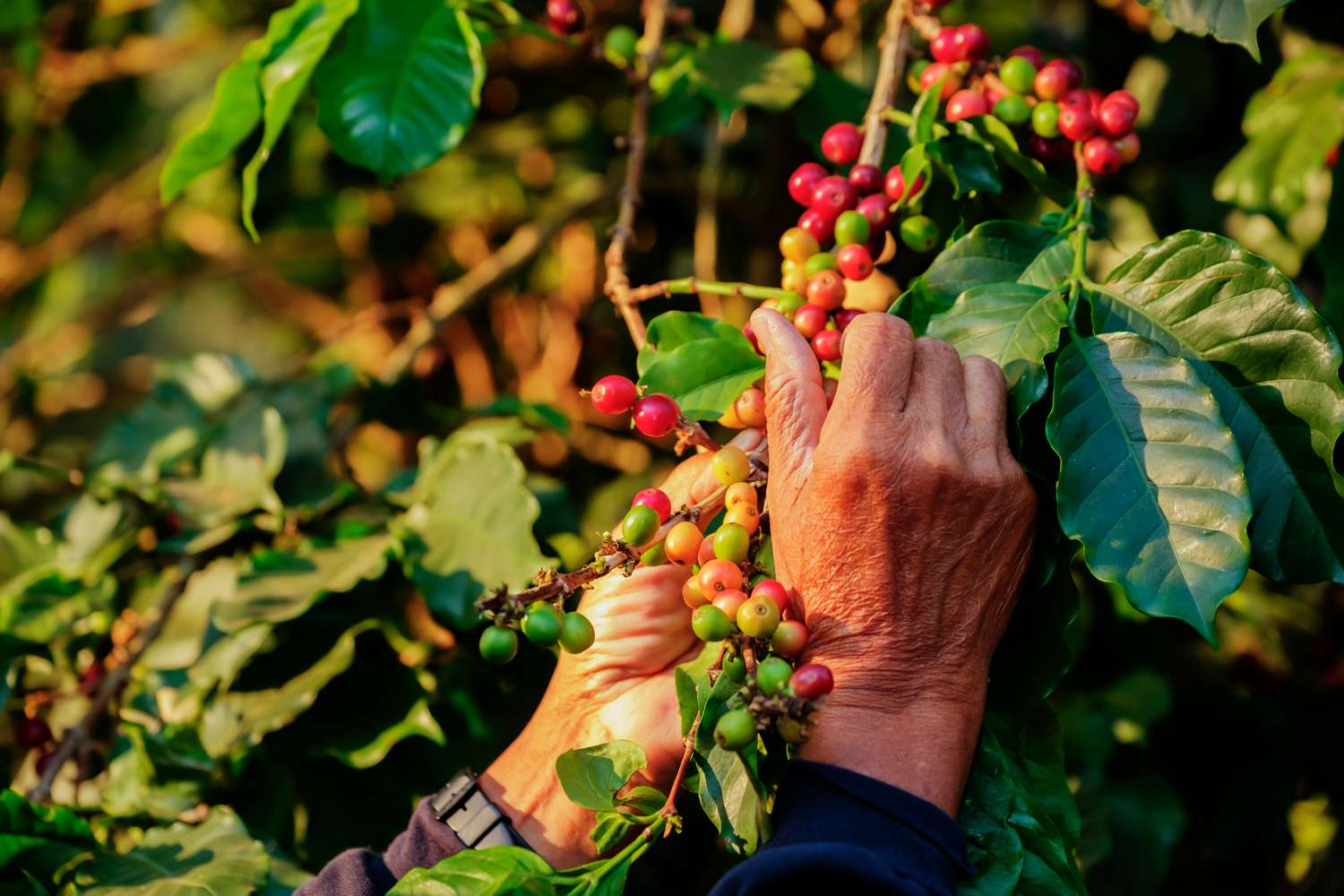Blog
Why Your Morning Coffee Costs More and What You Can Do

- Climate change is impacting coffee yields and increasing prices, causing concern for consumers and growers.
- Regenerative farming and techniques like composting can help lower costs and boost quality.
- Consumers can help by buying certified sustainable coffee and supporting environmentally conscious brands.
Andrea Illy, Chairman of the Italian coffee brand Illy, sipped a cappuccino at a recent breakfast in Manhattan and discussed the state of the Western Hemisphere’s favorite morning drink. “Now we have severely high coffee prices as a consequence of droughts last year in Vietnam and Brazil triggered by El Niño, the ocean current that goes back and forth across the South Pacific,” he explained.
El Niño and La Niña are two climate patterns. El Niño years bring warmer water and temperatures, but they trade off with cooler La Niña periods. Climate change has strengthened El Niño’s influence and expanded it, even to Atlantic locations like Brazil. That’s led to more droughts, which have decreased yields, driving up the cost of the green coffee that goes to roasters by nearly 55 percent—the most precipitous increase in half a century.
“Of course, the consumer pays the bill,” says Illy. In May, U.S. consumers spent an average of $7.93 per pound for roasted coffee, up $1.77 since 2023. “Coffee growers are unhappy with such a high price, too, because they say it’s unsustainable. Consumption will go down, and the price will collapse.”
Growers attempt to ride the boom by planting more trees, increasing production. “Then, the year after, the market is flooded with coffee, and the prices go down like a rock,” says Illy. It’s a typical trend. “We keep doing the same mistakes.”
Coffee trees—particularly Arabica, the main species—are highly susceptible to climate pressures. As the planet warms, estimates are that, by 2050, half as much land will be suitable for coffee. Growers will need to move higher in altitude. And diseases like coffee leaf rust, a fungus that’s decimated plants in every coffee-producing region around the world, will proliferate. Given that many farmers have few resources, we are looking at an uncertain future for our cups of joe.
Luckily, solutions are in the works. Coffee importers, researchers, advocates and governments are cooperating to support farmers. And consumers can help.
Sustainable Farming Practices
Coffee is farmed by a vast collection of small landholders in 70 countries across the Southern Hemisphere. Ninety-five percent of the 12.5 million coffee farms are less than five hectares, or 12 acres, in size. Sixty percent of the world’s coffee comes from small farms—yet it’s only in Vietnam and Brazil, where larger holdings are more common, that farmers earn enough to escape poverty.
That’s a social and environmental crisis. “Farmers living below the poverty line are often unable to withstand climate shocks,” say Tran Quynh Chi, regional landscapes director for Asia, and Mette-Marie Hansen, senior program manager for coffee, for the sustainable farming advocacy organization IDH, who answered questions together for this story. “Farmers struggling to survive often turn to unsustainable land expansion, clearing forests to grow more coffee or other crops.”
Deforestation degrades habitats, causes biodiversity loss and contributes to the climate change that is harming coffee in the first place. There are 12 million hectares (almost 30 million acres) of coffee in production worldwide—but compared to, say, soybeans, which are grown on nearly three times the land in the United States alone, coffee is a relatively small crop, so it causes less damage.
Still, says Raina Lang, Conservation International’s senior director for sustainable coffee, “it’s more like death by a thousand cuts. When prices are high and farmers see profit, they expand. When productivity is low, instead of working to increase their yield, they increase growing area to offset that loss.”
Both tactics lead to deforestation. That’s one reason Conservation International is collaborating with the United Nations’ Green Climate Fund to promote sustainable growing practices in Mexico, Guatemala, Honduras and Uganda, where 20 percent of small coffee farmers reside. The organization is training farmers to increase productivity on their existing land through sustainable practices. It has also created the Sustainable Coffee Challenge, partnering with roasters and large retailers (such as Aldi and Dunkin’) that pledge to buy only sustainable, responsibly sourced coffee, and also with research and tech partners committed to helping farmers increase profits in earth-friendly ways. The water-smart company Irrigation Technologies, for instance, provides coffee growers with its Deep Root Irrigation technology, saving them 60 percent of the water used by standard drip irrigation systems.
Other NGOs are doing the same. In Uganda, IDH’s Coffee Farmer Income Resilience Programme provides growers with World Bank–financed training to adopt regenerative practices, including adding fruit trees, row crops and apiaries. Growing other crops, say Chi and Hansen, can boost farmers’ income by 10 percent. And through its Initiative for Sustainable Landscapes (ISLA) program, IDH is helping farmers in Kenya and Vietnam transition to organic fertilizers, adopt rainwater catchment, manage cover crops for compost and soil health and recycle leftover coffee husks for mulch. These programs can not only increase profitability through alternative income streams but also improve the health and resilience of coffee farms.
Coffee brands are pitching in, as well. One such player is Illy, which is training growers in regenerative agriculture. Farmers feed the microorganisms in the soil with compost, creating soil biodiversity that fends off diseases, holds moisture and sequesters the carbon that would otherwise contribute to climate change. Farmers forgo chemicals and save money and emissions they would otherwise expend on ploughing. Illy reports that 90 percent of the company’s growers have adopted 70 percent of the regenerative practices honed on its research farms. The result? “Productivity is higher with cheaper production costs.” Beneficial insects and birds that eat agricultural pests thrive. “And the coffee is so much better.”
Yet, all these efforts won’t make a dent unless farmers can earn a real living. As Chi and Hansen point out, “When there is lack of income security, even the most well-designed sustainability programs risk failure.” IDH, therefore, is working to keep more money in farmers’ hands. Coffee’s annual market value is $200 billion, reports Illy, but farmers only see 5% of that. IDH, therefore, is working to increase farmers’ profits, providing technical and financial support for regenerative agriculture, which helps them lower production costs, secure premium prices and stabilize markets.
Better Genetics
Another issue has been a lack of investment in the trees that produce coffee berries. That’s particularly problematic under climate change. “Coffee is under-innovated,” says Hanna Neuschwander, senior communications advisor at World Coffee Research. “The number of apple varieties registered in the International Register of Varieties is over 5,000 since 1990, and for coffee it’s 120.”
Most coffee varieties were created in a breeding push after coffee leaf rust arrived in the Americas in the 1970s, but by now, those varieties have lost their ability to resist the mutating pathogen. World Coffee Research has thousands of varieties of coffee trees in trials. Four have made it into real-world trials in Guatemala, Peru and Costa Rica. Its first trees go to market in 2027, and Neuschwander is optimistic: “Human history is full of examples of running into a problem and innovating a solution. That’s the business we’re in.”
But research and development takes money. More than 200 coffee companies—including Starbucks, Intelligentsia, Keurig and Dr Pepper—subsidize World Coffee Research. Other efforts rely on government funding, and in the U.S., funding has been uncertain of late. For instance, many of Conservation International’s NGO partners were funded by the USDA or USAID. “That programming has stopped,” Lang says. “I’m sure that we’ll see impacts. A lot of the US investments in Central America were to improve livelihoods with the hope that farmers wouldn’t immigrate.” Indeed, sources report that the main driver of immigration from Central America since the first Trump term has been climate change, which has devastated coffee and other crops, leading farmers to seek a living up north.
Other governments have taken the opposite approach. They are working to improve coffee sustainability. The European Union, for instance, recently moved to require deforestation-free sourcing for seven products, including coffee.
How Consumers Can Help
Experts agree that consumers can help secure the crop for future coffee breaks. Conservation International’s Sustainable Coffee Challenge website lists roasters and retailers that source sustainable coffee. Though Lang says, “the easiest thing to do is look for a certification on a bag of coffee. While no certification is perfect, it is a sourcing strategy to promote best practices in environmental and social stewardship.” Fairtrade, Rainforest Alliance, Regenerative Organic and Regenagri, which certifies Illy, all use third-party auditing to ensure that production meets their standards. You may pay more for certified beans, but you’ll be helping farmers reinvest, protect the environment and secure their livelihoods, say Chi and Hansen.
Indeed, farmers who grow beans under certification programs earn more. For example, no matter what’s happening on the New York futures market (in which agreements are made to purchase coffee at a set price on a set future date), Fairtrade shelters farmers from fluctuations on the low end of the market by guaranteeing a minimum price for coffee sold to buyers under its certification program. That currently ranges from $1.80 for washed Arabica to $1.20 for natural Robusta.
On top of that, buyers pay a 20-cent Fairtrade premium, at least 25 percent of which farmers must use on infrastructure and social projects. If their coffee is also certified organic, they receive an additional 40 cents per pound. If the price for coffee on the commodities market ranges higher than the minimum, buyers pay the commodity price, and farmers still receive their premiums. In 2018 alone, says Fairtrade, farmers earned close to $89 million in Fairtrade premiums that were reinvested in farms and communities.
More broadly, says Illy, consumers can call for an economic system that recognizes the value of nature. “The extractive, linear system that we created with the Industrial Revolution depletes natural resources,” a process he says is self-destructive because we rely on those resources to live. “A regenerative economy puts natural capital at the same level as financial capital. As the regenerative economy grows, you regenerate natural capital.”
That mug in your hand is not just a caffeine fix; it can also drive a system that adequately compensates farmers and protects the environment, which in turn helps mitigate climate change, ensuring there’s coffee in the future. The immediate benefit to you? A more delicious cup and the gratification of supporting its producers.
The Bottom Line
The coffee industry has been affected by climate change, economic inequality and outdated farming methods. The dwindling coffee harvests have caused an increase in prices. And while consumers are paying higher prices, the coffee farmers are struggling. Organizations like IDH and Conservation International are implementing sustainable and regenerative farming practices to try to improve yields and assist farmers. Similarly, organizations like World Coffee Research are working to develop better coffee hybrids, but are facing setbacks due to funding cuts. Consumers can help protect and support the future of the coffee industry by choosing certified sustainable brands and companies that source ethically.










